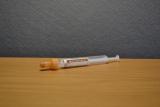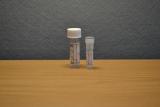Test Directory
Syphilis IgG EIA Serology
Containers - Adult

Brown Capped Gel Tube
|
Volume Range
4.9 ml |
Containers - Child

White Cap - Paediatric
|
Volume Range
1-2ml blood |
Reference ranges
Please refer to printed laboratory results report.
Laboratory Site
Old Dalkeith Road
Edinburgh
EH16 4SA
Transport arrangements
Inter-site van shuttle service, GP van service, External hospital van service, Couriers, Hospital porter collection (refer to collection times posted in wards / departments), Hospital Pneumatic Tube System (PTS)
Sample storage arrangements
Specimen transport arrangements must be in accordance with current postal and transport regulations. Samples should be transported to the laboratory without delay. If processing is delayed, refrigeration at 2-8 oC is preferable to storage at room temperature for all samples, with the exception of EDTA blood samples. EDTA blood samples must be stored at room temperature (19-23 oC). Patient samples can be transported at ambient temperature.
Special instructions for collection
Clinical samples must be collected into leak-proof containers and placed into a sealed bag with absorbent material. Patient samples must be individually packaged and not mixed with other patient samples. Any appropriate hazard labelling should be clearly visible on the sample bag / sample.
How to request
Use appropriate Virology Request Form, GUM Request Form or TRAK. Forms must be fully completed with Patient Identifier Number (CHI), Forename, Surname, Date of Birth, Gender and Location of patient (hospital and ward or primary care centre).
Availability
Weekdays 08.30 - 17.00
Anticipated turnaround
4 days
What happens if the result is positive or abnormal
Results are available in the patient’s records.
Confirmation testing may be required. Click here for further information.
Static information/disclaimer
False negative results may occur for a variety of reasons including: inappropriate timing of sample collection, inappropriate sample type, inappropriate sample storage and presence of virus below the detectable limit of the assay. New and emerging variants may also occur which may not be detected by specific assays. Towards the limit of detection of an assay sampling variation will result in lower reproducibility. Haemolysed or lipaemic samples can also cause interference with assay results.
General additional information
Please contact virologyadvice@nhslothian.scot.nhs.uk for all non-urgent clinical enquiries.